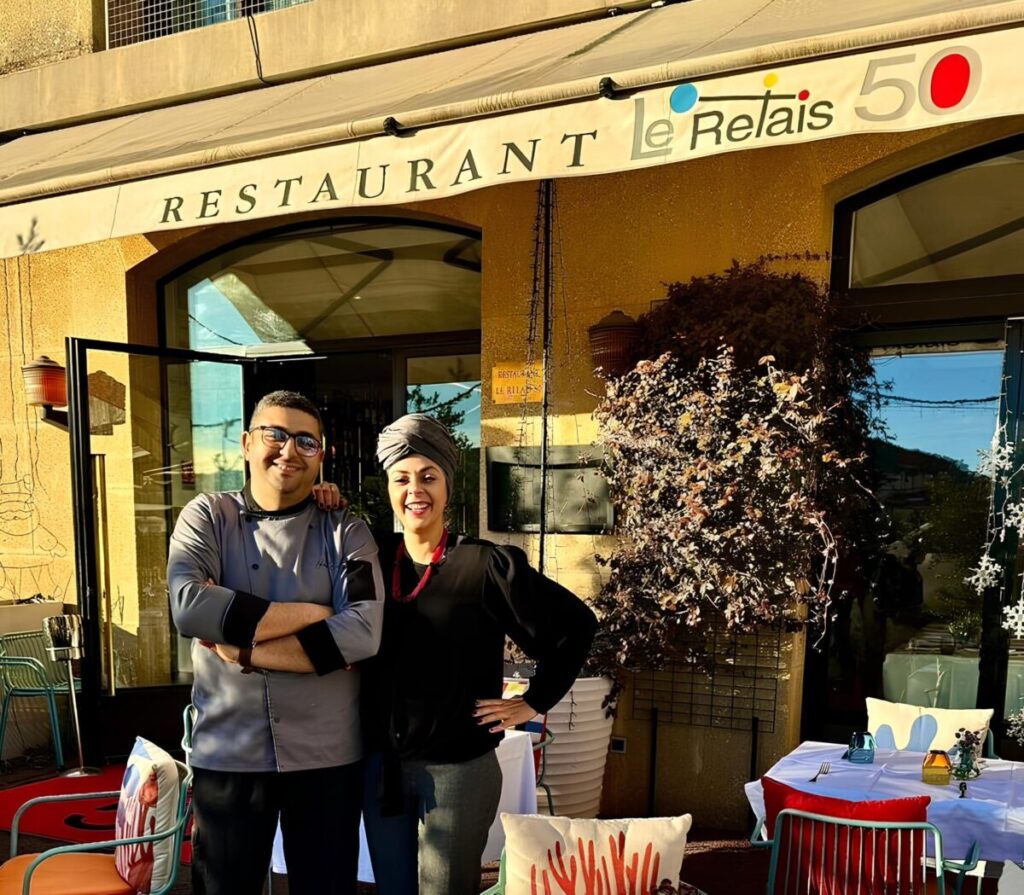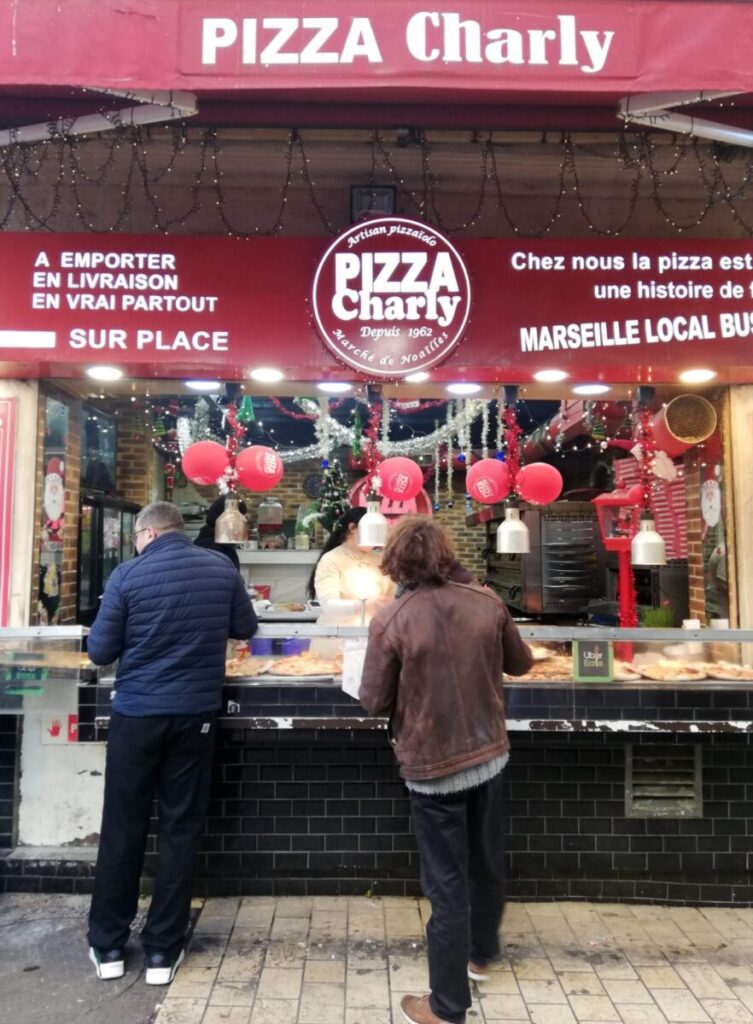« So let's eat »
If cuisine is not free from disputes of belonging or authenticity, recipes laugh at borders. The calentica, one of the variations of the chickpea flour cake that has sailed from adventure to adventure and from port to port for several centuries, is a crossroads in itself in the great culinary melting pot of the Mediterranean.
The winter sun shines through the front of Relais 50 in Marseille. Algerian chef Hamza Deramchi and his wife Lydia Merrouche, a lawyer turned sustainable agriculture advocate, took over this restaurant in the Old Port in October 2024 after falling in love with the Phocaean vibes. Hamza calls his sister to find out the exact proportions of their mother Zhor's garanteta. “ It’s a name that means flower ”, the chef notes, writing down the recipe measurements in volumes and not grams – maternal and popular kitchens do without precision scales. “ In Oran, we call it calentica because it comes from caliente, hot in Spanish, explains Hamza. In Algiers, we say rather garanteta. It’s the same word pronounced differently. ”

«Calentita », « karantika » or « garantita »
The list is not exhaustive – this classic street food from Algerian cuisine is not unknown in Marseille, where, thanks to the renewed popularity of chickpeas, it spreads its golden surface here and there. At the counter of Pizza Charly, a family institution in the cosmopolitan alleys of Noailles, it has long been a fixture beside the large window filled with pizzas, which themselves arrived in France with the Neapolitans through the great Phocaean port. To prepare Zhor's version, Hamza came to buy chickpea flour in this neighborhood nicknamed “ the belly of Marseille ”. He delights, in passing, in Charly's calentica generously dusted with cumin. Between Italian Marseille and African Marseille, the chickpea flour cooked with water acts as a binder. Love, too. The bakery that preceded Pizza Charly was created in 1962 by Charles Rodossio, a Pied-Noir from Naples, for his son who met here Nabya Alioui, of Algerian origin and the soul of the establishment for over forty years. Their son Charly, the third of the (pre)name, is the current owner.
“ Not long ago in Saint-Cyr-sur-Mer, I discovered the cade, a thinner cake than the calentica, but which resembles it ”, Hamza recounts as he walks down the Canebière to return to the Old Port. The chickpea, native to the Near East, surrounds the Mediterranean and, both north and south, several minimalist cakes have been feeding the poor and workers for ages. Their base is always the same: a mixture of chickpea flour and water, with variations in taste and texture depending on the dilutions and cooking.
Two main families emerge
In the first, which includes Provençal panisses and Sicilian panelle, the mixture is cooked into a porridge, poured into a mold, and then, once cooled and set, cut into pieces and fried in oil. The second, which includes notably Ligurian farinata, Tuscan cecina, fainè from Sassari in Sardinia, Niçoise socca, Var cade, or calentica, does not fall under the category of fritters: the dough, oiled and seasoned, is poured into a large dish and baked in a very hot oven. The calentica's version is sometimes enriched with egg and milk, even cheese. Above all, the Algerian cake is thicker and characterized by a layering of textures: the bottom, rather firm, is topped with a sort of creamy flan covered with a thin golden film that darkens in places due to the heat.
In the kitchen of Relais 50, the nourishing garanteta comes out of the oven. Hamza plunges a spoon into it and instantly returns to childhood. Lydia, drawn by the scents of chickpea and cumin, comes to slip a piece of cake into bread. “ The garanteta is our culinary heritage and our traditions,” she comments between bites. “We grew up with these smells, these spices, and these tastes. In the city, vendors open the white baguette in front of you, ask if you want harissa, then put the hot cake in the bread. ”
The calentica from street vendors, like the chilled glasses of agua limon with lemon, also populates the stories of Pied-Noirs and Sephardim. “ We sell a memory,” confirms Charly Rodossio in Noailles. “For the calentica, most of our customers are old Pied-Noirs.” Roland Bacri from Bal-el-Oued also mentioned it in the long preface of one of the first editions of Cuisine pied-noir by the Karsenty sisters (Denoël, 1974). “ A national cuisine, if you take away its ethnic character, what remains of it? ” he wondered at the beginning of this long and joyful plea for impurity. “The Pied-Noir gastronomy, excuse me, but to find it limited by borders or culinary barriers, if you have nothing to declare, it’s not my fault, it’s a fact. Our recipes are not bounded, that’s the truth. International, exotic, cosmopolitan, even ecumenical, despite being confined to the Mediterranean. ”
So, is the calentica Spanish?
The links between the two territories uniting Europe and Africa through a strait are very old, and Oran was occupied by Spain long before the arrival starting in 1830, in the Algeria colonized by France and notably in Oran, of many impoverished Spaniards who came there at the same time as other European migrants, particularly Italians or Maltese. The majority of the Moriscos expelled from Spain in the early 17th century settled on the coasts of North Africa, and a legend tells that the calentica was created by Spaniards a century later at the Santa-Cruz fort in Oran. The calentica is also present under the names of kalinti or karan in northern Morocco, just a stone's throw from the Iberian Peninsula, notably in Tangier and Oujda where it is accompanied by a refreshing drink made from citrus concentrate, the barida.
Liguria, the birthplace of farinata, also weaves its way everywhere with a troubling persistence. Genoa was, for several centuries, one of the greatest maritime powers in the Mediterranean. Its merchants seem to have enthusiastically exported their venerable cake. Later, in the 19th century, Genoese immigrants likely introduced it to Uruguay and Argentina. In these two Spanish-speaking countries, as in Spain, it is called fainá, which is also the name of farinata in Ligurian and resonates with the fainè of Sassari, alternately dominated by the Genoese and the Aragonese. Everything intertwines. In Gibraltar, where the Calentita Food Festival has been held annually since 2007, the renowned calentita, very close to farinata and socca, is said to have been brought in the 18th century by a Genoese colony in the village of Catalan Bay. England also borders the Mediterranean, and tirelessly, the calentica weaves together memories.
Recipe
The Garanteta of Zhor

Mix 1 glass of chickpea flour, 4 glasses of water, 2 tablespoons of powdered milk, 1 egg, 2 tablespoons of oil, salt, black pepper, and ground cumin. Watch out for lumps. Let it rest for 15 minutes.
Preheat the oven to 250 °C. Grease a rectangular stainless steel dish and sprinkle it with chickpea flour. Pour the batter and bake for 15-20 minutes while watching: the garanteta is ready when beautiful black spots form on the surface. Sprinkle it with cumin and eat it hot, as is or in a baguette sandwich with harissa.
The next Kouss•Kouss festival, held every summer in Marseille between late August and early September, will be dedicated to chickpeas.

